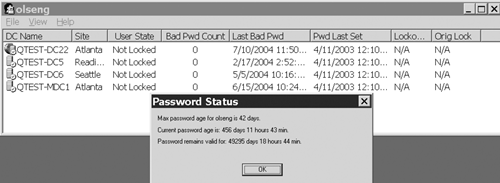Account Security
Account security consists of
password policy, account lockout policy, and Kerberos policy. You can
implement account security by applying Group Policies. Just as in
Windows 2000, you can apply account security only at the domain level in
Windows Server 2003. This is a very important concept. These settings
are located under Computer Configuration\Windows Settings\Security Settings\Account Policies and include password policy, account
lockout policy, and Kerberos policy settings. This means that settings
in any of these areas apply to objects only if they are applied in a GPO
at the domain level. They cannot be applied at the GPO level. This
means, for instance, that if you have a corporate password policy that
defines the minimum password length as eight characters, you must define
that in a GPO that is applied at the domain level. Further, if you have
a multiple domain structure, it must be defined at the domain level for
each domain. Note also that you can define these settings in GPOs that
are applied at the OU level, but they will never take effect.
For instance, if you define a GPO called Security at
the domain level and define the minimum password length to be eight
characters, and an OU Administrator creates a GPO called OUSecurity and
defines the minimum password length to be five characters, the effective
setting for the users will be eight characters, even without setting
the No Override option.
Security settings follow the same rules as other
settings if multiple GPOs are at the domain level that defines security.
These GPOs are listed in the Group Policy Editor in a list, as shown in
Figure 1.
The GPOs are processed bottom to top in the list. Thus, the GPO at the
top of the list has highest priority because it follows the last writer wins rule. In the example in Figure 1,
if the Administrators policy has password length set to ten, the
accounting policy has it set to eight, and the default domain policy has
it set to five, the effective policy will be five because the default
domain policy is highest in the list and it's the last one processed (it
overrides the others due to the last writer wins operation).
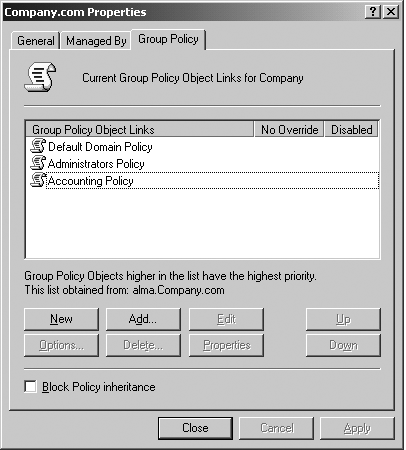
tip
Account policies cannot be applied from OU-based
GPOs, only from domain-based GPOs. Although they can be defined in the
GPO template, they will not be applied.
Account Security and DCs
One of the most important things for you to note in
GPO design is that DCs just act differently when applying security. A
good example is a customer who complained that he had defined the
account security settings in the default domain policy at the domain
level to have a minimum password length of 6 and retain a history of 15
passwords. However, when his users tried to change their passwords, they
get a notification that passwords must be 10 characters and it retains a
history of 6 passwords. We looked at the local security database (sdb)
on a test client and it indicated the effective setting was a length of 6
and history of 15. We ran GPResult from an XP client (GPResult is
built-in to 2003 and XP), and it indicated that the applied security
settings were 6 and 15. Yet when we attempted to change the password, we
got a message saying the settings were 10 and 6. We then discovered
that logging in to the client with a local account allowed us to change
to a 6-character password. Logging in to a domain account gave us the
other settings of 10 and 6. We eventually discovered that the client had
blocked inheritance on the DCs OU because it didn't want their desktop
lockdown policies to apply to DCs. Because DCs get their security
settings from the domain GPO like everyone else, this blocked them from
getting the correct security settings of password length = 6 and history
=15. Prior to setting the block inheritance option, the security policy
had settings defining password length = 10 and history = 6. Those
settings were written into the local sdb of each DC. Because that is the
only security the DCs could see and the DCs actually apply their
security to clients they authenticate, the clients were getting the DC's
version of security, rather than what was defined at the domain level.
The important points here are to understand this
scenario that shows how DCs determine security policy, and remember to
not set the block inheritance option at the DC's OU.
Account Lockout
Perhaps one of the most frustrating issues in Windows
2000 Security is that of account lockout. Account lockout is a security
feature that permits the Admin to have an account locked out (deny
login privileges) when a bad password has been attempted for a certain
number of tries. Although intended to prevent hackers from easily
guessing account names and passwords, it becomes a big help desk issue
for legitimate users who get locked out, typically during a password
change operation. The issue is complicated by replication latency
between the DC that the help desk technician changes the password on and
the DC that authenticates the user.
Account lockout became such a huge issue at Compaq
prior to the HP merger that scripts were run nightly to reset accounts
and others were developed to be triggered by the user selecting an
option in an automated phone message.
Microsoft made the claim at the release of Windows
2000 SP3 that the account lockout issue was solved, but it's still a
problem area. Not to say anything is particularly broken or a bug that
should be fixed, but it's a problem Administrators have to deal with. It
is important to understand this issue and develop account lockout
strategies accordingly.
Account lockout is implemented as a security policy
at the domain level or for local user accounts. Three settings comprise
account lockout policy, as shown in Figure 2:
Account Lockout Threshold:
The number of failed logon attempts (range 0 to 99,999) before the user
account is locked out. The lower the number, the more secure you are
from hackers guessing the password; however, low numbers also increase
calls to the help desk. Microsoft recommends 10, which makes account
lockout a little more tolerant. After an account is locked out, it
cannot be used until reset by an Administrator or until the Lockout
Duration period has expired. A value of 0 prevents the account from
being locked out.
Reset Account Lockout Counter:
The number of minutes (range 1 to 99,999) after a failed logon attempt
before the failed logon attempt counter is reset to 0. A lower number
here makes it less secure, but makes the user wait longer to reset the
password without calling the help desk to have the account reset. If the
Account Lockout Threshold is defined, the reset counter value must be
less than or equal to the Account Lockout Duration value.
Account Lockout Duration:
The number of minutes (range 0 to 99,999) that an account remains locked
out before it is reset and becomes unlocked. A setting of 0 causes the
account to remain locked out until manually reset by an Administrator.
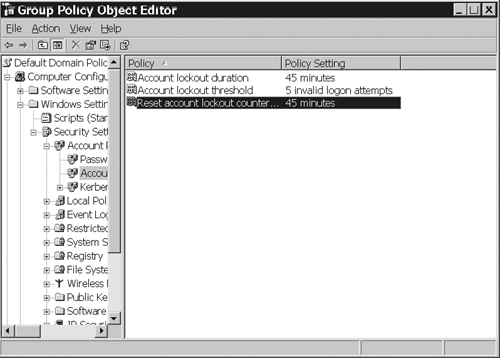
tip
Attempting to set values for the Reset Account
Lockout Counter or the Account Lockout Duration that violates the
interdependency rules noted here will cause a pop-up message indicating
what the value must be set to. You cannot set them to incompatible
values.
In addition, features are built in that prevent you
from defining settings that are incompatible with these rules. For
example, in Company.com, I configured the Account Lockout Duration to 60
minutes. A pop-up message, shown in Figure 3,
informed me that the Account Lockout Threshold and Account Lockout
Duration would be changed to 5 attempts and 30 minutes, respectively.
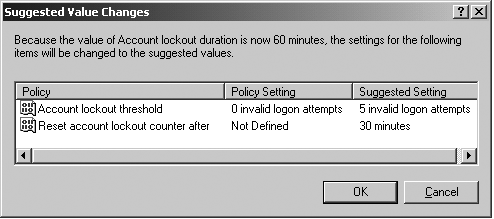
Microsoft doesn't go out of its way to tell you that
resources, such as shares or interactive sessions on multiple computers
using those credentials, cause account lockout policy to be such a
problem. For instance, if you are logged in with a single account to a
Terminal Server session on a server in the lab with an interactive logon
to your laptop and have a VPN connection from home, and you change your
password from your laptop without logging the other sessions off, your
account soon will be locked out. This has never been an issue in Windows
NT 4.0 domains, so what's so new in AD that could cause this issue?
Kerberos. When users log on from Kerberos-capable clients (Windows 2000
and greater) and authenticate against an AD domain, the Kerberos
protocol is used instead of the NTLM protocol (as was the case in
Windows NT 4.0). However, to tighten security in the Windows world, the
Kerberos credentials expire after a defined period of time (maximum
lifetime for a user or Ticket Granting Ticket is ten hours by default),
which causes a machine to re-evaluate a user's credentials over time
against an AD DC (Kerberos Distribution Center). If the password has
been changed without logging on and off, the credential validation takes
place with the old password and thus soon locks out the account.
In addition, having shares mapped using those
credentials will have the same effect. Most likely, in our network, if I
change my password and haven't logged off all sessions and disconnected
all shares using that account, it will be locked out within about 15
minutes. Before changing my password, I have to go through all my home
network computers, lab servers, laptop, and desktop to make sure I'm
logged off from all Terminal Server, Remote Desktop, and interactive
sessions, as well as to make sure all the shares are disconnected. Once
it took me three days to find all the sessions I had going, because I
tend to not log out of the lab machines to save time when testing.
Let's follow a couple of scenarios to see how this works. Consider the configuration shown in Figure 4.
User Nancy in San Jose forgets her password. The incorrect password is
attempted at the authenticating DC in San Jose, SJC-DC3. Because the
password is incorrect, the password request is sent to the PDC Emulator,
ATL-DC1, in case the password was changed and this DC isn't aware of
it. This fails and Nancy gets the invalid username or password error.
She tries five times, at which time her account is locked out by the PDC
by setting the lockoutTime on the user account, and SJC-DC3 locks it out as well. The PDC now replicates the lockoutTime
to all DCs, informing them of when the account was locked out so they
can make the comparison for the Account Lockout Duration time.
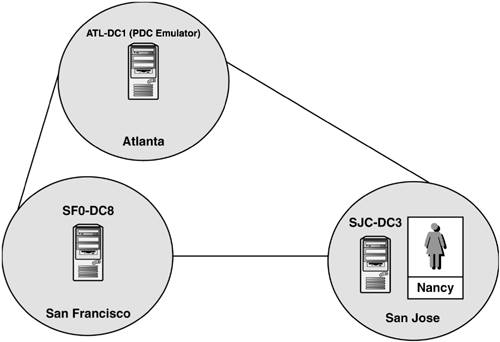
Nancy could wait for the Account Lockout Duration
period of three hours to expire before trying again or she could call
the help desk to have it reset. However, suppose Nancy has to drive to
San Francisco for a meeting. She connects to the company network and
attempts to log in again two hours after the account was locked out.
Here, the authenticating DC is SFO-DC8, which hasn't had the lockout
message replicated yet. It refers the request to the PDC and the client
gets the account lockout message.
Now Nancy calls the help desk technician who resets
the password and then expires the password, forcing Nancy to change it
again when she logs in. The Admin, however, is in Atlanta and he resets
the password on ATL-DC1. The account reset is replicated urgently, but
the password change is not. Before replication makes it to SFO-DC8,
Nancy tries the new password. The request is passed to the PDC who
authenticates it, but SFO-DC8 prompts Nancy to change the password.
Because SFO-DC8 doesn't know about the password set by the Admin, it
gives Nancy a failure and she might retry it until it locks out again.
To prevent this, the Admin can change the password on the user's local
DC, in this case, SFO-DC8.
Microsoft created a couple of tools that help in this
matter. One, the acctinfo.dll, registered on each DC, provides the
Additional Account Info tab in the user account attributes dialog box,
as shown in Figure 5.
Note the Set PW on Site DC button at the lower left of the dialog box.
Assuming the subnet/site mapping is correct, this will force the change
to take place initially on a DC in the user's site. Note that Site
Affinity is a function of the workstation, so the reset takes place at
the site where the user's workstation exists. In the previous example,
Nancy's normal “home” site is San Jose, but because she uses DHCP, when
she connects to the network in San Francisco, her laptop's Site Affinity
is San Francisco so the authentication is to SFO-DC8.
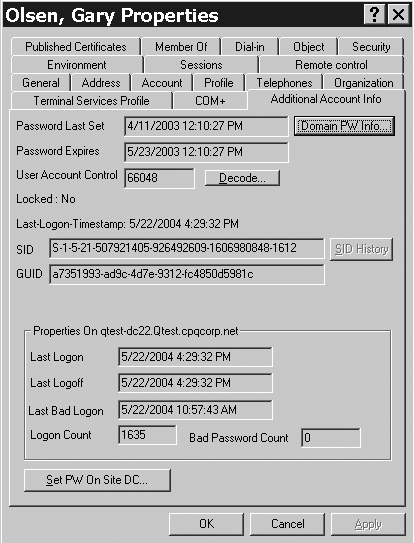
Another scenario could be that Nancy successfully
changes her password, but forgets that she has several drives mapped to
shares using the old credentials and the account is locked out. She
calls the help desk; they reset the account and password. Nancy logs in,
changes the password, and awhile later the account is locked out. Nancy
sees the account is locked out when she tries to use Outlook, map a new
share, or perform any other operation requiring her to specify
credentials. The message that the account is locked out is a clear
indication of the problem. Nancy would have to make sure all drive
mappings are disconnected and all Terminal Server and interactive logon
sessions are logged off—except the one used to change the password.
Another tool Microsoft has provided is the LockoutStatus.exe utility. Figure 6
shows the features of this tool. Note that it identifies each user, the
account's locked status, the bad password count, and so on. This gives
you the ability to monitor the account lockout status. You also can see
in the figure that the user's current password settings are displayed.
This user is in a test domain with a password that doesn't expire, which
is why the numbers in this example, such as current password age, are
so high.
